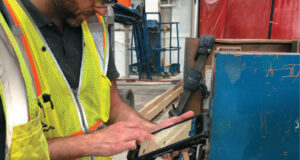Abraham Lincoln has often been quoted as saying, “Give me six hours to chop down a tree and I will spend the first four sharpening the axe.” No matter the provenance of that quote, the meaning remains true:
Planning and preparation work.
This is especially true in the pulp, paper, and converting industries. On any given day there are hundreds of individuals operating, maintaining, and fixing equipment. Many are company employees; others are contractors who come onsite to a mill or plant to perform a myriad of services, ranging from routine maintenance to herculean efforts like rigging, lifting, and removing hundreds of thousands of pounds of equipment. While maintenance tasks may seem mundane in comparison, all require a dedicated focus on safety.
In a recent interview for TAPPISAFE, Precision Industrial Contractors, Inc. (PIC) Safety Director Todd Sizemore discussed the complexities of preparing contract workers to successfully and safely perform their duties in mill and converter locations. Sizemore, who spent 34 years in safety management roles both in mills and corporate programs, recently moved to the other side of the equation—preparing contract workers to execute duties safely onsite at customers’ mills and converting plants.
“My past experience managing onsite mill programs gives me a unique perspective,” Sizemore noted. To minimize risk on both sides, an assessment and audit must be completed before any team members arrive onsite.
To begin, a planning group is convened and reviews a list of expected tasks and pictures of the jobsite. The job superintendent provides a punch list of tools, equipment, PPE, and other job-related necessities. In terms of safety, Sizemore investigates what workers will be doing and when, such as whether the job is being conducted during operations or outages. “Every situation poses different risks,” he says, “and the planning process must be all-encompassing for the safety of every worker.”
To illustrate, Sizemore offers an example. “If we need to excavate through concrete, we use different types of tools—saws, jackhammers, grinders. Not only do we need to plan for the necessary tools, but also the debris they release, noise and vibration issues, and clean-up. It isn’t just about a single tool or digging a hole, it’s about ensuring a properly planned process. What we do on the frontside helps ensure we have the right systems and tools in place to safely complete the work.”
Because they work on contracts, many of Sizemore’s people spend time on the road at customer locations. As a company that specializes in heavy industrial work, including rigging, providing a consistent source for safety education and training is vital, so the online resources PIC uses have become extremely important. They are available anywhere, at any time, and cover a broad range of topics from lockout/tagout and confined spaces to crane operations and rigging. Their content must engage employees and keep them connected to the importance of safety—regardless of whether they are online or in person. They must also be timely, relevant, and strategic.
“There are rules and laws for everything we do—from moving thousands of pounds of papermaking equipment to digging holes,” he says. “Every task has a safety component attached to it, which is why ongoing training and education is so important.”
It’s also why their safety requirements include daily Safety Tasks Assessment and tool reviews. “The site superintendents are the consistent voice of safety. They are responsible for all job tools being compliant. Each day the team goes through a ‘toolbox topic’ and a safety assessment on what’s being used that day. After work, they sign off on how they used and maintained the tools.”
Sizemore points to PIC’s expertise in rigging as a primary example of how one “tool” requires intense planning before operating on the job. Every rigging job comes with its own hazards and involves elements such as the specific load being lifted, the jobsite, and equipment type. At one site, PIC was contracted to remove thousands of pounds of papermaking equipment and transport it to a new location; planning for that job required many hours.
“Rigging is a huge deal. Before we move a single piece of equipment, we have to analyze dozens of safety factors and provide hours of training. We have to think through line-of-fire issues—will it come down straight, or side-to-side? How do we keep workers safely out of the line of fire while working at great heights or on the ground? How do we put it in a shipping container and safely transport it? It’s like putting together a 1,000-piece puzzle and never dropping a single piece.”
Or like cutting down a tree with a carefully sharpened axe.
TAPPISAFE is a web-based orientation program that allows the workforce to take training online so they arrive at the mill ready for gate entry; learn more at tappisafe.org. Learn more about Precision Industrial Contractors, Inc. at picateam.com.
 Paper 360
Paper 360

